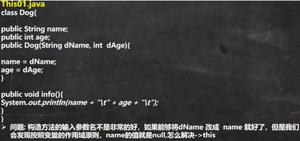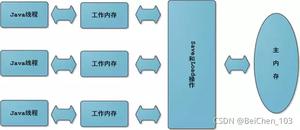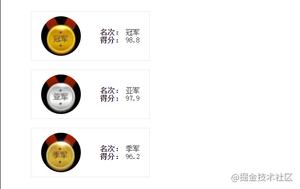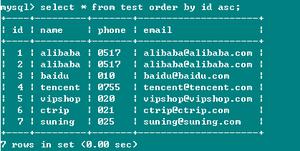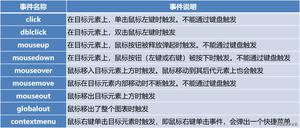关于js里的this关键字的理解
this关键字在c++,java中都提供了这个关键字,在刚开始学习时觉得有难度,但是只要理解了,用起来就方便多了,下面通过本篇文章给大家详解js里this关键字的理解。
关于this,是很多前端面试必考的题目,有时候在网上看到这些题目,自己试了一下,额,还真的错了!在实际开发中,也会遇到 this 的问题(虽然一些类库会帮我们处理),例如在使用一些框架的时候,例如:knockout,有时候不明白为什么不直接使用this,而要把 this 作为参数传入。
接下来你谈谈我对它的理解,也作为一个笔记,方便以后参阅。有不对的地方,欢迎指出批评。
1. 不像C#,this一定是指向当前对象。
js的this指向是不确定的,也就是说是可以动态改变的。call/apply 就是用于改变this指向的函数,这样设计可以让代码更加灵活,复用性更高。
2. this 一般情况下,都是指向函数的拥有者。
这一点很重要!这一点很重要!这一点很重要!
这也是一道常见的面试题,如下代码:
<script type="text/javascript">
var number = 1;
var obj = {
number: 2,
showNumber: function(){
this.number = 3;
(function(){
console.log(this.number);
})();
console.log(this.number);
}
};
obj.showNumber();
</script>
由于showNumber方法的拥有者是obj,所以this.number=3; this 指向的就是 obj 的属性 number。
同理,第二个 console.log 打印的也是属性 number。
为什么第二点说一般情况下this都是指向函数的拥有者,因为有特殊情况。函数自执行就是特殊情况,在函数自执行里,this 指向的是:window。所以第一个 console.log 打印的是 window 的属性 number。
所以要加一点:
3. 在函数自执行里,this 指向的是 window 对象。
扩展,关于this,还有一个地方比较让人模糊的是在 dom 事件里,通常有如下3种情况:
如下:
1. 使用标签属性注册事件,此时this 指向的是 window 对象。
<input id="test" type="button" value="按钮" onClick="test()"/>
function test(){alert(this)}
2. 对于1,要让 this 指向 input,可以将 this 作为参数传递。
3. 使用 addEventListener 等注册。此时this 也是指向 input。
document.getElementById("test").addEventListener("click",test);
在面向对象编程语言中,对于this关键字我们是非常熟悉的。比如C++、C#和Java等都提供了这个关键字,虽然在开始学习的时候觉得比较难,但只要理解了,用起来是非常方便和意义确定的。JavaScript也提供了这个this关键字,不过用起来就比经典OO语言中要"混乱"的多了。
下面就来看看,在JavaScript中各种this的使用方法有什么混乱之处?
1、在HTML元素事件属性中inline方式使用this关键字:
// 可以在里面使用this
">division element
// 可以在里面使用this
">division element
我们一般比较常用的方法是在此使用:javascirpt: EventHandler(this),这样的形式。不过这里其实可以写任何合法的JavaScript语句,要是高兴在此定义个类也可以(不过将会是个内部类)。这里的原理是脚本引擎生成了一个div实例对象的匿名成员方法,而onclick指向这个方法。
2、用DOM方式在事件处理函数中使用this关键字:
division element
var div = document.getElementById('elmtDiv');
div.attachEvent('onclick', EventHandler);
function EventHandler()
{
// 在此使用this
}
// -->
division element
var div = document.getElementById('elmtDiv');
div.attachEvent('onclick', EventHandler);
function EventHandler()
{
// 在此使用this
}
// -->
这时的EventHandler()方法中的this关键字,指示的对象是IE的window对象。这是因为EventHandler只是一个普通的函数,对于attachEvent后,脚本引擎对它的调用和div对象本身没有任何的关系。同时你可以再看看EventHandler的caller属性,它是等于null的。如果我们要在这个方法中获得div对象引用,应该使用:this.event.srcElement。
3、用DHTML方式在事件处理函数中使用this关键字:
division element
lt;mce:script language="javascript">
var div = document.getElementById('elmtDiv');
div.onclick = function()
{
// 在此使用this
};
/ -->
division element
var div = document.getElementById('elmtDiv');
div.onclick = function()
{
// 在此使用this
};
// -->
这里的this关键字指示的内容是div元素对象实例,在脚本中使用DHTML方式直接为div.onclick赋值一个EventHandler的方法,等于为div对象实例添加一个成员方法。这种方式和第一种方法的区别是,第一种方法是使用HTML方式,而这里是DHTML方式,后者脚本解析引擎不会再生成匿名方法。
4、类定义中使用this关键字:
function JSClass()
{
var myName = 'jsclass';
this.m_Name = 'JSClass';
}
JSClass.prototype.ToString = function()
{
alert(myName + ', ' + this.m_Name);
};
var jc = new JSClass();
jc.ToString();
function JSClass()
{
var myName = 'jsclass';
this.m_Name = 'JSClass';
}
JSClass.prototype.ToString = function()
{
alert(myName + ', ' + this.m_Name);
};
var jc = new JSClass();
jc.ToString();
这是JavaScript模拟类定义中对this的使用,这个和其它的OO语言中的情况非常的相识。但是这里要求成员属性和方法必须使用this关键字来引用,运行上面的程序会被告知myName未定义。
5、为脚本引擎内部对象添加原形方法中的this关键字:
function.prototype.GetName = function()
{
var fnName = this.toString();
fnName = fnName.substr(0, fnName.indexOf('('));
fnName = fnName.replace(/^function/, '');
return fnName.replace(/(^\s+)|(\s+$)/g, '');
}
function foo(){}
alert(foo.GetName());
function.prototype.GetName = function()
{
var fnName = this.toString();
fnName = fnName.substr(0, fnName.indexOf('('));
fnName = fnName.replace(/^function/, '');
return fnName.replace(/(^\s+)|(\s+$)/g, '');
}
function foo(){}
alert(foo.GetName());
这里的this指代的是被添加原形的类的实例,和4中类定义有些相似,没有什么太特别的地方。
6、结合2&4,说一个比较迷惑的this关键字使用:
view plaincopy to clipboardprint?
function JSClass()
{
this.m_Text = 'division element';
this.m_Element = document.createElement('DIV');
this.m_Element.innerHTML = this.m_Text;
this.m_Element.attachEvent('onclick', this.ToString);
}
JSClass.prototype.Render = function()
{
document.body.appendChild(this.m_Element);
}
JSClass.prototype.ToString = function()
{
alert(this.m_Text);
};
var jc = new JSClass();
jc.Render();
jc.ToString();
function JSClass()
{
this.m_Text = 'division element';
this.m_Element = document.createElement('DIV');
this.m_Element.innerHTML = this.m_Text;
this.m_Element.attachEvent('onclick', this.ToString);
}
JSClass.prototype.Render = function()
{
document.body.appendChild(this.m_Element);
}
JSClass.prototype.ToString = function()
{
alert(this.m_Text);
};
var jc = new JSClass();
jc.Render();
jc.ToString();
我就说说结果,页面运行后会显示:"division element",确定后点击文字"division element",将会显示:"undefined"。
7、CSS的expression表达式中使用this关键字:
height: expression(this.parentElement.height);">
division element
height: expression(this.parentElement.height);">
division element
这里的this看作和1中的一样就可以了,它也是指代div元素对象实例本身。
8、函数中的内部函数中使用this关键字:
view plaincopy to clipboardprint?
function OuterFoo()
{
this.Name = 'Outer Name';
function InnerFoo()
{
var Name = 'Inner Name';
alert(Name + ', ' + this.Name);
}
return InnerFoo;
}
OuterFoo()();
function OuterFoo()
{
this.Name = 'Outer Name';
function InnerFoo()
{
var Name = 'Inner Name';
alert(Name + ', ' + this.Name);
}
return InnerFoo;
}
OuterFoo()();
运行结果显示是:"Inner Name, Outer Name"。按我们在2中的讲解,这里的结果如果是"Inner Name, undefined"似乎更合理些吧?但是正确的结果确实是前者,这是由于JavaScript变量作用域的问题决定的,详细了解推荐参看"原来JScript中的关键字'var'还是有文章的"一文及回复。
归纳起来,JavaScript中的this用法有以下3种(详细用法参原文):
1.在HTML元素事件属性 或 CSS的expression表达式 中inline方式使用this关键字——对应原文的1、7
2.在事件处理函数中使用this关键字——对应原文的2、3
其中可分为两种方式
(1)DOM方式——此种方式的结果是this指向窗口(window)对象
(2)DHTML方式——此种方式的结果是this指向div元素对象实例
3.在类定义中使用this关键字并在其 内部函数 或 成员函数(主要是prototype产生)中使用——对应原文的4、5、8
需要说明的是,在函数也是个对象,因此需要区分 变量定义 和 成员变量定义,如下:
view plaincopy to clipboardprint?
var variableName; //变量定义
//作用域:函数定义范围内
//使用方法:直接使用variableName
this.varName; //成员变量定义
//作用域:函数对象定义范围内及其成员函数中
//使用方法:this.varName
var variableName; //变量定义
//作用域:函数定义范围内
//使用方法:直接使用variableName
this.varName; //成员变量定义
//作用域:函数对象定义范围内及其成员函数中
//使用方法:this.varName
以上归纳出的三类this的使用方法中,第一种比较容易理解,这里对原文中第6点提到的程序进行了测试和改进如下,以说明上述后两种使用方法:
view plaincopy to clipboardprint?
function JSClass()
{
var varText = "func variable!"; //函数中的普通变量
this.m_Text = 'func member!'; //函数类的成员变量
this.m_Element = document.createElement('DIV'); //成员变量,创建一个div对象
this.m_Element.innerHTML = varText; //使用函数的普通变量
this.m_Element.attachEvent('onclick', this.ToString); //给这个对象的事件连上处理函数
this.newElement = document.createElement('DIV');
this.newElement.innerHTML = "new element";
this.newElement.m_Text = "new element text!"; //给创建的对象建个成员
this.newElement.onclick = function()
{
alert(this.m_Text); //指向div对象的成员
};
}
JSClass.prototype.Render = function()
{
document.body.appendChild(this.m_Element); //把div对象挂在窗口上
document.body.appendChild(this.newElement);
}
JSClass.prototype.ToString = function()
{
alert(this.m_Text); //指向窗口(window)对象
};
function initialize(){
var jc = new JSClass();
jc.Render();
jc.ToString(); //里面的this指向JSClass类的实例,里面有m_Text成员
}
// -->
initialize();
// -->
function JSClass()
{
var varText = "func variable!"; //函数中的普通变量
this.m_Text = 'func member!'; //函数类的成员变量
this.m_Element = document.createElement('DIV'); //成员变量,创建一个div对象
this.m_Element.innerHTML = varText; //使用函数的普通变量
this.m_Element.attachEvent('onclick', this.ToString); //给这个对象的事件连上处理函数
this.newElement = document.createElement('DIV');
this.newElement.innerHTML = "new element";
this.newElement.m_Text = "new element text!"; //给创建的对象建个成员
this.newElement.onclick = function()
{
alert(this.m_Text); //指向div对象的成员
};
}
JSClass.prototype.Render = function()
{
document.body.appendChild(this.m_Element); //把div对象挂在窗口上
document.body.appendChild(this.newElement);
}
JSClass.prototype.ToString = function()
{
alert(this.m_Text); //指向窗口(window)对象
};
function initialize(){
var jc = new JSClass();
jc.Render();
jc.ToString(); //里面的this指向JSClass类的实例,里面有m_Text成员
}
// -->
initialize();
// -->
上面的代码执行结果是:
页面加载时,弹出对话框,输出func member!
页面上显示
func variable!
new element
单击func variable时,弹出对话框,显示undefined
——因为这时toString函数里的this指针指向window
单击new element时,弹出对话框显示new element text!
——因为这时toString函数里的this指针指向div元素,而该元素已经定义了m_Text成员(this.newElement.m_Text = "new element text!")
以上是 关于js里的this关键字的理解 的全部内容, 来源链接: utcz.com/z/320783.html

